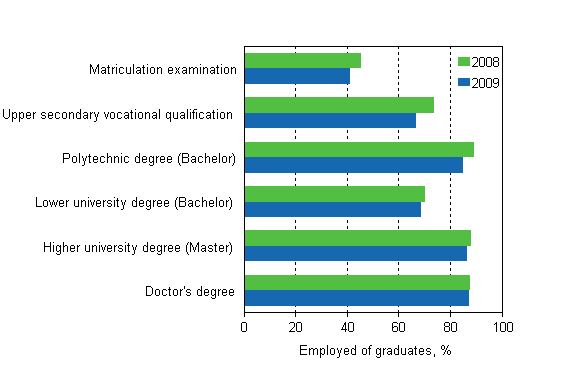Published: 2 March 2011
Finding employment became more difficult for recent graduates in 2009
Finding employment became more difficult for recent graduates in 2009. According to Statistics Finland, their rate of employment was 68 per cent, or good three percentage points lower than in the year before. Finding employment was most difficult for attainers of upper secondary vocational qualifications. Their rate of employment was 67 per cent, having been 74 per cent twelve months earlier. The rate of employment among attainers of polytechnic degrees was 85 per cent, or four percentage points lower than in the previous year. The proportion of those with higher university degrees, such as master's degrees, having found employment was 86 per cent, or two percentage points lower than in the previous year. Those with doctor's degrees found employment as easily as in the year before.
Employment of graduates one year after graduation by level of education 2008 and 2009, %

Employment among recent graduates is measured one year after graduation. In 2008, the total number of attained degrees or qualifications was 136,300, or good 12,000 higher than the year before. The increase was due to the restructuring of degrees in university education. However, persons with higher university or doctorate degrees found employment more easily than recent graduates from other sectors of education although the number of graduates from university education was much higher than in the previous year.
The proportions of the unemployed and those continuing studies went up by a couple of percentage points. The proportion of the unemployed grew from seven to nine per cent. At 15 per cent, the proportion of the unemployed was the highest among attainers of upper secondary vocational qualifications. Eight per cent of the graduates from polytechnics and six per cent of the graduates with higher university degrees were unemployed. Studies were most often continued by those having passed the matriculation examination or attained a lower university degree.
Men’s transition into working life grew more difficult than women’s. The rate of employment among all recently graduated men was 60 per cent, or five percentage points lower than in the year before. The respective rate among women was 73 per cent, or two percentage points lower than in the previous year. The rate of employment was 59 per cent for men and 75 per cent for women among attainers of upper secondary vocational qualifications. Eighty-three per cent of men and 86 per cent of women with polytechnic degrees were employed. Eighty-eight per cent of men and 85 per cent of women with higher university degrees had found jobs. Among those with doctorate degrees, the rate of employment was 86 per cent for men and 88 per cent for women.
There were differences in the transition to working life by field of education. Employment deteriorated most among graduates from the field of technology and transport. Their rate of employment was 64 per cent, which is 10 percentage points lower than in the year before. The transition was smoothest for attainers of qualifications in the fields of safety and security, welfare, health and sport, social sciences, business economics and administration. Their employment rate was over 80 per cent. In all fields of education, the transition was easier for those with university degrees than for those with upper secondary qualifications. At 22 per cent, the rate of unemployment was highest for those with upper secondary qualifications in the field of technology.
Examined by region, the rate of employment varied from 78 per cent in Åland to 58 per cent in North Karelia. Besides Åland, the rate of employment was higher than the average for the whole country in the regions of Uusimaa, Itä-Uusimaa, Ostrobothnia and Kanta-Häme.
Source: Education 2011. Statistics Finland
Inquiries: Ritva Kaukonen (09) 1734 3311, koulutustilastot@stat.fi
Director in charge: Jari Tarkoma
Publication in pdf-format (230.3 kB)
- Tables
-
Tables in databases
Pick the data you need into tables, view the data as graphs, or download the data for your use.
Appendix tables
Updated 2.3.2011
Official Statistics of Finland (OSF):
Transition from school to further education and work [e-publication].
ISSN=1798-9469. 2009. Helsinki: Statistics Finland [referred: 18.12.2025].
Access method: http://stat.fi/til/sijk/2009/sijk_2009_2011-03-02_tie_001_en.html

